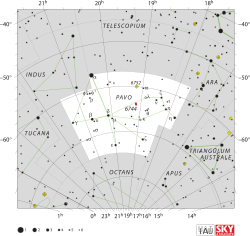Pavo (constellation)
| Constellation | |

|
|
| Abbreviation | Pav |
|---|---|
| Genitive | Pavonis |
| Pronunciation |
/ˈpeɪvoʊ/, genitive /pəˈvoʊnᵻs/ |
| Symbolism | the Peacock |
| Right ascension | 18h 10.4m to 21h 32.4m |
| Declination | −56.59° to −74.98° |
| Family | Bayer |
| Quadrant | SQ4 |
| Area | 378 sq. deg. (44th) |
| Main stars | 7 |
|
Bayer/Flamsteed stars |
24 |
| Stars with planets | 6 |
| Stars brighter than 3.00m | 1 |
| Stars within 10.00 pc (32.62 ly) | 4 |
| Brightest star | α Pav (Peacock) (1.91m) |
| Nearest star |
SCR 1845-6357 (12.57 ly, 3.85 pc) |
| Messier objects | 0 |
| Meteor showers |
Delta Pavonids August Pavonids |
| Bordering constellations |
Octans Apus Ara Telescopium Indus |
|
Visible at latitudes between +30° and −90°. Best visible at 21:00 (9 p.m.) during the month of August. |
|
Pavo is a constellation in the southern sky with the Latin name for peacock. It is one of twelve constellations conceived by Petrus Plancius from the observations of Pieter Dirkszoon Keyser and Frederick de Houtman. Pavo first appeared on a 35-cm (14 in) diameter celestial globe published in 1598 in Amsterdam by Plancius and Jodocus Hondius and was depicted in Johann Bayer's star atlas Uranometria of 1603. French explorer and astronomer Nicolas-Louis de Lacaille gave its stars Bayer designations in 1756. The constellations Pavo, Grus, Phoenix and Tucana are collectively known as the "Southern Birds".
The constellation's brightest member, Alpha Pavonis, is also known as Peacock and appears as a 1.91-magnitude blue-white star, but is actually a spectroscopic binary. Delta Pavonis is a nearby Sun-like star some 19.9 light-years distant. Six of the star systems in Pavo have been found to host planets, including HD 181433 with a super-earth, and HD 172555 with evidence of a major interplanetary collision in the past few thousand years. The constellation contains NGC 6752, the third-brightest globular cluster in the sky, and the spiral galaxy NGC 6744, which closely resembles the Milky Way but is twice as large. Pavo is the radiant of two annual meteor showers: the Delta Pavonids and August Pavonids.
...
Wikipedia
